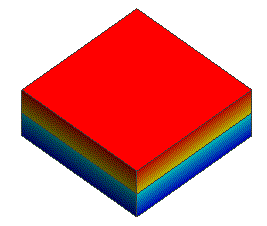
CAE Software【Femtet】Murata Software Co., Ltd.

Example18 Electric Resistance Set on Boundary Face

General
-
This model consists of two bodies. Their interface has electric resistance. The voltage is applied to them.
-
The distribution of the potentials and the current density are solved.
-
Unless specified in the list below, the default conditions will be applied.
Analysis Space
|
Item |
Setting |
|
Analysis Space |
3D |
|
Model Unit |
mm |
Show Results
|
Item |
Setting |
|
Solver |
Electric Analysis [Coulomb] |
|
Analysis Type |
Static Analysis (Resistance) |
|
Options |
None |
Model
The model consists of two rectangular solid bodies made of aluminum. They share a boundary face.
The electric wall boundary condition is set on the bottom face and the top face. The electric resistance is set as a boundary condition on the boundary face of the two bodies.
Body Attributes and Materials
|
Body Number/Type |
Body Attribute Name |
Material Name |
|
0/Solid |
conductor |
001_Al * |
|
1/Solid |
conductor |
001_Al * |
* Available from the material DB
Boundary Condition
|
Boundary Condition Name/Topology |
Tab |
Boundary Condition Type |
Setting |
|
100volt/Face |
Electric |
Electric Wall |
100 [V] |
|
0volt/Face |
Electric |
Electric Wall |
0 [V] |
|
Electric Resistance/Face |
Electric |
Electric Resistance |
1.0×10^(-6 )[ohm] |
Results
The potential distribution is shown below.
The voltage changes discontinuously on the face, on which the electric resistance is set.
The current density vectors are shown below.
The integral of the heat flux is calculated by Integral on Results Window. Calculation result of the current density on the top face of the body is shown below.
Theoretical value is calculated as shown below. Analysis results almost match with the theoretical value.
Electric resistance of body [ohm] = Thickness in current density direction [m] / (cross sectional area [mm^2] x conductivity[1/ohm/m] ),
Body dimensions: 10[mm] x 10[mm] x 2[mm], Electric conductivity of aluminum: 3.767×10^7[1/ohm/m]
With these items above, calculation is done as below.
Total electric resistance = electric resistance of upper body + electric resistance at boundary + electric resistance of lower body
= 2 x 10^-3 / ( 3.767×10^7 x 100 x 10^-6) + 1.0×10^-6 + 2 x 10^-3 / ( 3.767×10^7 x 100 x 10^-6)
= 2.0619×10^-6 [ohm]
Current[A] = potential[V] / total electric resistance[ohm]
= (100 – 0 ) / (2.0619×10^-6)
= 4.85×10^7 [A]

